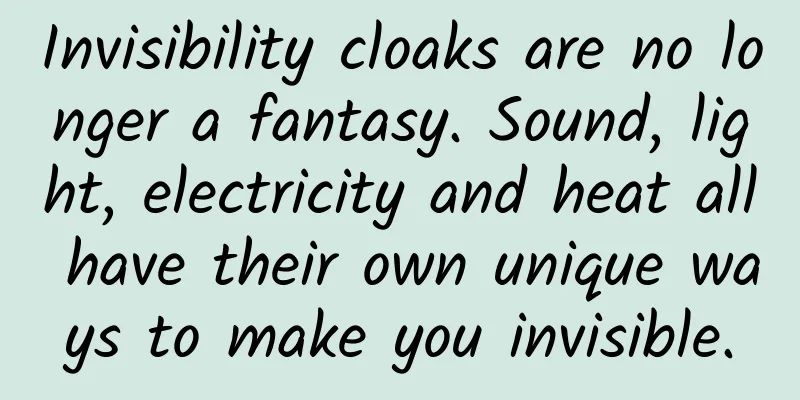Invisibility cloaks are no longer a fantasy. Sound, light, electricity and heat all have their own unique ways to make you invisible.

|
Since ancient times, humans have imagined the ability to be invisible. "Invisibility" still often appears in literary works or video games - often in the form of magic or science fiction. The invisible cloak of the protagonist in the world-famous "Harry Potter" satisfies our fantasy of invisibility cloaks. In fact, this optical invisibility cloak that allows light to "pass through" the body has been developed. Not only that, scientists have conducted extensive and in-depth explorations on the invisibility of matter in different physical environments, and have constructed different types of invisibility cloaks that are absolutely beyond your imagination. Written by Xu Lei (Professor of the Department of Physics, Chinese University of Hong Kong) Achieving invisibility has always been a dream of mankind since ancient times: from the invisibility of Sun Wukong in "Journey to the West" to Harry's invisibility cloak in "Harry Potter", this dream has attracted widespread attention from people all over the world. Invisibility in a narrow sense only refers to being invisible to the eyes, while in a broader sense, invisibility is not limited to the eyes, but generally refers to being unable to be detected by a certain detection method (such as radar, sonar), which is called invisibility under this detection method. Achieving invisibility has important applications in the military, such as stealth aircraft and stealth ships can approach targets silently, so stealth technology has become the research focus of various countries in the military field. With the development of science and technology, various types of invisibility cloaks have been successfully realized in many different physical fields, and continue to become a research hotspot in different fields. What is the principle of invisibility cloaks? What are the different types of invisibility cloaks? How are they realized? If you can wear an invisibility cloak one day, what kind of surprise (scare) do you plan to give your relatives and friends? If you are interested in these questions, this article is carefully prepared for you. How Invisibility Cloaks Work To achieve invisibility, let us first understand why we can see. A common situation is that the light reflected or scattered by an object enters our eyes, so that we can see the object (as shown in the figure below): Junior high school physics textbook (People's Education Press) Knowing this principle, one can't help but have a bold idea: if a piece of clothing can completely absorb light without reflecting or scattering any light, can it be invisible? As we all know, black can absorb light very well. If you wear a super black cloak covering your whole body (as shown in the picture below), can you do whatever you want on the street? Things are far from that simple. Stills from Batman Begins Obviously, although Batman's black clothes absorb all the light in the picture above, the contrast with the bright background completely exposes Batman, so invisibility cannot be achieved by absorbing light alone. Since an object's reflection, scattering, and absorption of light will reveal its location, how can we achieve invisibility? Harry Potter's invisibility cloak provides us with the right idea (as shown in the figure below): Stills from Harry Potter and the Sorcerer's Stone In the picture, Harry Potter's invisibility cloak achieves the goal of neither reflecting nor scattering light, nor absorbing light, but allowing the light to propagate along its original path without being affected at all. When the light around Harry can freely pass through his body without being affected in any way, his body "disappears" out of thin air - we can clearly see the background wall behind him but cannot see his body. Therefore, the basic principle of designing an invisibility cloak is to make the propagation of light unaffected by objects. Although the principle is simple, the realization is difficult: because most objects are opaque, light cannot penetrate them and continue to propagate. How to make light unaffected by objects? The current basic idea is to design a layer of material with a special structure to wrap the object, and this special material can allow light to bypass the object and continue to propagate along the original propagation path (as shown in the figure below). This layer of material with a special structure is an invisibility cloak. GIF source: gfycat.com How to make light bypass an object? The common practice is to first calculate the required refractive index theoretically, and then find a material with this refractive index to realize it experimentally. An important theoretical calculation method is the transformation optics theory proposed by Professor John Pentry of Imperial College London and his collaborators in 2006. The key is to use coordinate transformation to transform a point with zero volume into a region with non-zero volume, and hide the object in this special region. Since a point with zero volume will not have any effect on the propagation of light, the special region transformed from it will also have similar properties, thereby achieving the effect of light bypassing an object. The specific refractive index parameters can be obtained from the coordinate transformation, as shown in the figure below: Professor John Pentry Spatial transformation: transforming a point into an area So the essence of an invisibility cloak is to create an area that light will bypass and hide the object in it, thus achieving invisibility. This method has been realized in experiments, such as using several lenses to create an area that light will completely bypass. When an object is placed in this area, the outside world cannot detect it at all. How about this special space, which can be called a hide-and-seek artifact? Do you also want to own it and use it to implement some bold plans? Image source: Choi, JS, & Howell, JC Optics Express (2014) Implementation of different types of invisibility cloaks Although this invisible space created by using lenses is feasible, it is far less convenient and practical than an invisibility cloak, which can be made invisible by simply covering an object. To achieve an invisibility cloak like Harry Potter, we need to control the deflection of light at will and make it bypass the object. This deflection method is generally impossible to achieve in natural materials, and only negative refractive index materials can do it successfully. To achieve negative refractive index, a special material is used: metamaterial. Negative refractive index metamaterial Image source: Wikipedia Metamaterials are usually not natural materials, but artificial materials constructed through the design of functional primitives and the special spatial arrangement of primitives. They can exhibit many novel and extraordinary physical properties and are widely used in many fields such as optics, mechanics, and acoustics, such as optical negative refractive index materials, mechanical negative Poisson's ratio materials, and acoustic sound absorption materials. Left: Negative refractive index metamaterial. Right: Positive refractive index normal material. Image source: Dolling et al., Optics Express, 2006. (1) Electromagnetic wave invisibility cloak Using metamaterials, scientists first realized an electromagnetic wave invisibility cloak at microwave frequencies in 2006 (see the figure below). Microwaves are electromagnetic waves like visible light, but the wavelength is on a longer scale (millimeter to meter). The microwave ovens we commonly use use electromagnetic waves in this band to heat food. Although this invisibility cloak does not look "invisible" at all at visible light wavelengths, it is invisible at a specific microwave wavelength (3.5 cm), and the objects inside it are also hidden and cannot be detected by this 3.5 cm microwave wavelength. (a) Structural design of microwave cloak. (b) Numerical simulation of cloak shows that microwaves continue to propagate after passing through the cloak. (c) Experimental results are consistent with simulation results. Image source: D. Schurig, et al., Science, 314, 977 (2006) Following the microwave invisibility cloak, scientists have also developed invisibility cloaks for visible light, and there are many different types. A common design is the carpet-type invisibility cloak: it can hide an object under a carpet-type invisibility device, and for observers nearby, the effect is just like a flat ground, thus making the object invisible. The design principle is essentially to reflect or refract the light that should have shone on the object through a special mirror or hidden device to bypass the object and propagate along the original path. Image source: wikimedia Image source: IOA (2) Optical invisibility cloak Using this design, scientists successfully achieved a carpet-like optical invisibility cloak in 2009 (see the figure below). When there is no invisibility cloak, the object will scatter light in all directions (lower left figure), but once the invisibility cloak is put on, the propagation direction of the light is exactly the same as that of a smooth floor (lower middle figure): Observers at a distance will mistakenly think that there is only a floor without an object (lower right figure), which successfully achieves invisibility. Image source: Valentine, Jason, et al. Nature Materials 8 (7), 568-571 (2009). There is also a very important practical principle when designing an invisible cloak, that is, the thinner the invisible cloak, the better. If you can be invisible by wearing it like a thin piece of clothing, it will naturally be more convenient and practical than a set of heavy armor. Based on this principle, scientists have developed an ultra-thin optical invisible cloak: by covering the surface of an object with a layer of 80 nanometers thick nanoantenna, this layer of nanoantenna can not only adjust the direction of the reflected light but also adjust the phase of the reflected light, thereby reflecting light like a smooth plane and disguising the object as a smooth ground (see the figure below). This layer of ultra-thin nanoantenna is obviously very similar to an invisible cloak, but it only works on a specific wavelength of light (730nm). In order to achieve a broad-spectrum invisible cloak that works on the entire visible light band, the current technology is not yet mature, and scientists need to make further efforts. Image source: Ni, Xingjie, et al., Science 349.6254 (2015): 1310-1314. Obviously, advanced science and technology have gradually turned optical invisibility cloaks from film and television stories into reality. Can you put on an optical invisibility cloak and scare your friends at any time? Smart readers may say: Even if I close my eyes, I can detect someone approaching from the sound of footsteps. This is indeed the case. Sound waves and ultrasound waves can also be used to detect objects, such as bats flying in the dark, B-ultrasound examinations, sonar detection of fish schools and submarines, etc., all use sound waves or ultrasound waves to detect objects. Correspondingly, the research on invisibility cloaks for sound waves and ultrasound waves is also in full swing. (3) Acoustic invisibility cloak The basic principle of acoustic cloak is the same as that of optical cloak: acoustic cloak can be achieved by making the object have no effect on the propagation of sound waves. A specific example is shown in the figure below. Scientists have designed and realized a metamaterial acoustic cloak composed of 16 concentric rings: these concentric rings can guide sound waves to bypass the object in the center to achieve acoustic invisibility. If only the object is placed in the sound field, it will have a greater impact on the sound field (upper row of pictures); after adding the cloak, the propagation of the sound field is basically unaffected (lower row of pictures). Acoustic cloak also has very important application prospects in many fields: such as anti-sonar detection of submarines, design of sound insulation facilities, etc. Image source: Zhang, S., Xia, C., & Fang, N. (2011). Physical review letters, 106(2), 024301 (4) Other types of invisibility cloaks In addition to optical and acoustic cloaks, are there other cloaks? The answer is yes: thermal cloaks are also a common type of cloak. As we all know, many objects, including the human body, have temperatures that are different from the surrounding environment. Based on this temperature difference, objects can be detected using temperature measuring devices such as infrared detectors. Therefore, scientists can design corresponding thermal cloaks: through similar principles, thermal metamaterials can be designed for heat flow propagation equations and corresponding thermal cloaks can be manufactured. When wearing this thermal cloak, the temperature of the human body is consistent with the background temperature, thereby achieving thermal invisibility, as shown in the infrared photo below. Image credit: Adam Harvey Inspired by the above-mentioned invisibility cloaks, recent research hotspots have begun to focus on achieving invisibility in flow fields. Flow field invisibility cloaks seek to minimize the disturbance of objects to the flow field, thereby making it impossible for the outside world to detect objects from changes in the flow field. This flow field invisibility cloak was first realized in a porous medium flow field in 2019, as shown in the following schematic diagram: the flow field is straight when there is no object (a), the flow field is disturbed after the object is placed (b), and the flow field returns to straightness after being covered with a layer of flow field invisibility cloak (c). This flow field invisibility cloak is of great significance in the fields of underwater vehicle stealth and underwater drag reduction. Image source: J Park, JR Youn, YS Song, Physical review letters, 2019 Similarly, the thinner the flow field cloak, the better. In view of this, our team (Professor Xu Lei's research group at the Chinese University of Hong Kong) has developed the world's thinnest shell-type cloak. Our design cleverly combines the inner layer of the double-layer stealth design with the hidden object, further reducing the double-layer stealth design to a single-layer stealth, thereby achieving the thinnest flow field cloak - its thickness is only 0.3% of the hidden object in the middle. As shown in the figure below: Theoretical calculations show that the flow field is straight when there is no object (A), the flow field is distorted after the object is placed (B), and the flow field becomes straight again after covering our ultra-thin flow field cloak (C). Numerical simulations show similar results (D, E, F). Experiments further verify that the streamlines are straight when there is no object (G), the streamlines become curved after the object is placed (H), and the streamlines become straight again after the object is covered with our ultra-thin cloak (I). This ultra-thin cloak is of great significance for achieving near-field invisibility of objects. Image source: Chen, M., Shen, X., & Xu, L. (2022). The Innovation, 100263. summary In summary, there are various physical fields in nature, such as light field, sound field, temperature field, flow field, and so on. Various invisibility cloaks can be developed for different physical fields as effective anti-detection means. These invisibility cloaks can be used alone or combined to form super invisibility cloaks for multiple physical fields. With the increasing improvement of detection methods, the research on anti-detection stealth is also rising. What new black technology will be born from it? Let us wait and see! Acknowledgements: We would like to thank Dr. Mengyao Chen and Dr. Xiangying Shen for providing materials and pictures for this article. References 1. Choi, JS, & Howell, JC Optics Express, Vol. 22, Issue 24, pp. 29465-29478 (2014). 2. Gunnar Dolling, Martin Wegener, Stefan Linden, and Christoph Hormann, Optics Express, Vol. 14, Issue 5, pp. 1842-1849 (2006). 3. D. Schurig, et al., Science, 314, 977-980 (2006). 4. Valentine, Jason, et al. Nature Materials 8(7), 568-571 (2009). 5. Ni, Xingjie, et al., Science 349, 6254, 1310-1314 (2015). 6. Zhang, S., Xia, C., & Fang, N, Physical review letters, 106, 024301 (2011). 7. J Park, JR Youn, YS Song, Physical review letters, 123, 074502 (2019). 8. Chen, M., Shen, X., & Xu, L. The Innovation, 3(4), 100263 (2022). Produced by: Science Popularization China Special Tips 1. Go to the "Featured Column" at the bottom of the menu of the "Fanpu" WeChat public account to read a series of popular science articles on different topics. 2. Fanpu provides a function to search articles by month. Follow the official account and reply with the four-digit year + month, such as "1903", to get the article index for March 2019, and so on. Copyright statement: Personal forwarding is welcome. Any form of media or organization is not allowed to reprint or excerpt without authorization. For reprint authorization, please contact the backstage of the "Fanpu" WeChat public account. |
<<: Look once, it's weird, look again
>>: Super Typhoon Xuanlannuo, what is its origin?
Recommend
Security experts recommend not installing these apps on your phone
In recent weeks, tech news headlines have been fi...
Comprehensive understanding of iOS static library development
[[148702]] Introduction In enterprise development...
High spirits! 2021 National Day Tiananmen Square and Chang'an Avenue Flowerbed Plan Released! Sneak Peek →
On the afternoon of September 16, the Beijing Mun...
Don’t know how to plan advertising? Here is a complete set of templates!
Information flow advertising is now the new favor...
The iPhone is mediocre because Apple didn't put in the effort to research new patents
Apple has accelerated its layout in the field of ...
Xi'an City General Election Arrangement Booking Price and Fees are Real and Reliable
The prices and fees for arranging appointments fo...
Are mobile programmers going to be out of business under the big front-end trend? These advanced skills will help you turn things around
In the context of market contraction and the tren...
How to quickly achieve user growth through active traffic generation?
Nowadays, not only works of art, but as long as v...
Liu Yiwei's "21 Ways to Get Commissions" plans commission designs suitable for the company's stage of development
Liu Yiwei's "21 Ways to Get Commissions&...
As thin as paper! MIT scientists develop new high-quality speakers with imaginative applications
Engineers at MIT have developed a new type of ult...
Beware! A child was buried alive while digging sand on the beach. This seemingly relaxing game may actually be a deadly risk.
Edit: Thanks Digging sand on the beach can defini...
The number of infected people has exceeded 1,000! The latest report from this place
The latest data released by the Anhui Provincial ...
Remembering! The backbone of China
In the year 2021, which is about to pass, 27 acad...
Sony PS 5 is in short supply, and the console King of Glory is expected to sell more than 300 million units in the end
A digital product that is not a financial product...
This comment section is more dangerous than poisonous mushrooms!
Don’t use hallucinogenic mushrooms as medicine! E...









